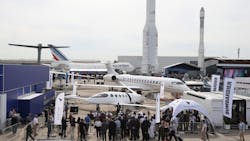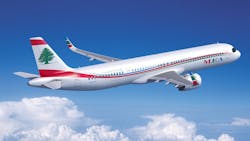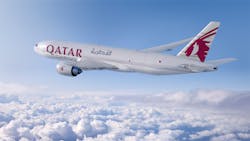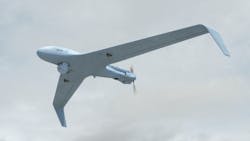A look back at deals and technologies announced at the 53rd International Paris Air Show
PARIS - While the Paris Air Show will go on until Sunday, the ink has dried on contracts and aviation experts and executives have largely returned to their respective countries and companies to drive innovation and forge alliances that will be on display next summer at the Farnborough International Airshow.
Manufacturers Boeing and Embraer had good news for the industry, as the pair of companies announced that they expected good growth in the next two decades. Boeing forecasts a 20-year market expectation at $8.7 trillion - up $600 billion from a year ago.
The Boeing Market Outlook (BMO) released June 17 at the Le Bourget Airport noted a strong commercial aviation industry, stable defense spending and the need to service all platforms throughout their lifecycle are driving a growing aerospace and defense market.
Brazil's Embraer said in Paris that it expects that over the next 20 years it forecasts a steady market demand for 10,550 new aircraft with up to 150 seats worldwide, worth $600 billion. Market growth will drive 55% of total demand and the remaining 45% will be delivered to replace ageing aircraft.
On the technology front, there was a lot of emphasis on “green” flight. On Thursday, the Pipistrel ALPHA ELECTRO 167 took to the skies powered by its 60kW electric engine. With mega-companies like Boeing and Airbus investing in electric technology for their autonomous “flying taxis” and manufacturers like GE developing commercial engines that employ electric motors, it seems evident that hybrid-electric flight could soon become the new norm in aircraft manufacturing.
“Can we build an all-electric 787 to compete with today’s planes? Absolutely not,” said Eviation’s Omer Bar-Yohay to Al Jazeera. “The technology’s not even close to that. But to fly at this speed, at this size, and to beat those designs that are out there since the ‘70s and ‘80s, well, here it is. This was built the way we believe planes in the twenty-first century should be built.”
In addition to electric and hybrid-electric powered aircraft, Boeing announced at Paris that it was investing in Brazil’s efforts to establish a sustainable aviation fuel industry. The investment will focus on initiatives that maximize social, economic and environmental benefits to local communities engaged in the development of feedstock that can be used to produce sustainable aviation fuel (SAF). In 2018, the company provided an additional USD 1 million to the industry’s efforts in Brazil.
“Brazil is a biofuel powerhouse and we believe this leadership can translate into benefits for small farmers and communities at the forefront of the multi-feedstock supply chain supporting biojet fuel production in the country,” said Marc Allen, senior vice president of Boeing and president of Embraer Partnership & Group Operations.
On the ‘bus
Of course, the vast majority of the aircraft on display – and in the skies – at Le Bourget were powered by fossil fuels, and myriad deals were made between manufacturers, carriers, and leasing companies. Airbus made a splash on the first day of the show when it formally unveiled its 321XLR (for “xtra long range”) single-aisle commercial aircraft that will travel 4,000 nautical miles while burning 30% less fuel than last-gen aircraft from competitors, according to Airbus. The aircraft, which measures 146 feet long, with a cabin measuring 113 feet, will hold between 180 and 220 passengers in a typical two-class configuration.
Embraer also made news on Monday when it completed a deal with United Airlines to provide the American carrier up to 39 E175s. The order comprises 20 firm aircraft and 19 options in a 70-seat configuration. The order has a value of $1.9 billion, based on Embraer's current list prices, with all options being exercised. The firm order will be included in Embraer's 2019 second-quarter backlog. Deliveries are expected to begin in the second quarter of 2020. These aircraft will replace older 70-seat aircraft currently operated by United's regional partners.
All said, Embraer announced the sale of 78 aircraft, worth around $4.6 billion at the air show.
Back to the MAX
However, the biggest surprise of the show may have happened when Boeing announced that the International Airlines Group (IAG) would be purchasing 200 of their MAX jets. The two companies said they have been in discussions regarding the possible purchase, and signed a letter of intent at Paris. Speculators note that IAG likely saw a sizable discount on the list price of the aircraft, but the purchase may instill confidence in other carriers possibly following suit.
IAG is the parent company of Aer Lingus, British Airways, Iberia, Vueling and LEVEL that fly more than 113 million passengers a year combined. The group has been a long-time operator of Boeing twin-aisle airplanes. Earlier this year, IAG group committed to and finalized a major order for Boeing's newest long-haul model, the 777X, to complement its fleet of current-generation 777s and new 787 Dreamliners.
Military millions
There were also interesting displays and demonstrations on the military side of things at the expo as French manufacturer Dassault had on display a rough look at what the Future Combat Air System (FCAS) jet will look like when it takes to the skies for the first time in 2026. The fighter is being developed by Dassault alongside Airbus, and will be put into service by Spain and Germany in addition to France.
Elbit Systems’ Hermes 45 Small Tactical Unmanned Aircraft System (STUAS) made its first public appearance at the company’s static display area (A-8) at this year's Paris Airshow 2019.
Hermes 45 offers a unique combination of extended range and duration with point launch and recovery, to and from land and maritime platforms thus enhancing Intelligence, Surveillance, Target Acquisition and Reconnaissance (ISTAR) capabilities at the brigade and division levels and also for naval squadron units.
While the focus of my coverage at Paris is on the deals, components, technology, and aircraft, I’d be remiss not to mention the fine folks who made all of this possible. This was my first time to the world’s largest aviation expo, and I certainly hope it won’t be my last. The scale of the event was indeed, as I predicted, bigger than anything I’ve experienced before, but the industry was equally informative as they were hospitable, and I received a warm welcome into this very large community.
To read all of Intelligent Aerospace’s coverage of the Paris Air Show from this and previous years, please click here to browse all of the news coming out of Le Bourget. Until 2021, au revoir from Paris!
About the Author
Jamie Whitney
Senior Editor
Jamie Whitney joined the staff of Military & Aerospace Electronics in 2018 and oversees editorial content and produces news and features for Military & Aerospace Electronics, attends industry events, produces Webcasts, and oversees print production of Military & Aerospace Electronics.




